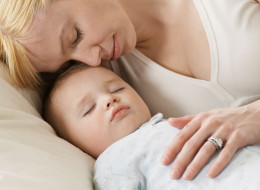
By Lisa Rapaport
(Reuters Health) Children are seven times more likely to sleepwalk if both parents have a history of nocturnal strolls, a Canadian study finds, suggesting that the habit runs in families.
“The findings point to a strong genetic influence on sleepwalking and, to a lesser degree, sleep terrors,” said lead study author Dominique Petit, of the Center for Advanced Research in Sleep Medicine, at Sacred Heart Hospital in Montreal. “We tend to believe it is one of the genes involved in deep sleep, or slow wave sleep, but it has not been shown yet in humans.”
Petit and colleagues reviewed more than a decade of data on 1,940 children born in Quebec in 1997 and 1998 to assess whether they had sleep terrors as toddlers or sleepwalked as they got older.
Researchers questioned the children’s mothers about sleep terrors (intense episodes of screaming and flailing) and found that about one third of kids experienced these around 1.5 years old. By age 5, only about 13 percent of children had sleep terrors, and by age 13, only about 5 percent did.
Sleepwalking, however, was less common in younger children and became more prevalent with age, the researchers found. About 13 percent of children aged 10 to 13 were sleepwalkers.
The children who had sleep terrors early in life were more likely to sleepwalk later. About 34 percent of kids who had sleep terrors also became sleepwalkers, compared with about 22 percent of children who never had sleep terrors.
Sleep terrors were slightly more common when children had parents with a history of sleepwalking, the study found.
Parental sleepwalking, however, was much more closely linked to sleepwalking in kids.
Children with one parent who sleepwalked were three times more likely to do this than kids who didn’t have a parental history of nocturnal strolls.
Overall, about 25 percent of children without a parental history developed sleepwalking, compared with about 47 percent of kids with one parent who sleepwalked and about 62 percent of children with two parents who sleepwalked.
One weakness of the study is its reliance on parents to report sleep terrors and sleepwalking, rather than physician assessments or sleep studies, the researchers wrote in JAMA Pediatrics. Parents may not be able to distinguish between nightmares and sleep terrors.
Still, the findings suggest that parents who have a history of sleepwalking may want to take extra precautions to ensure that their children sleep in a space that is safe enough to prevent injuries if kids walk around in the middle of the night, Petit said.
“With sleep terrors, kids tend to stay put and just scream, so you don’t have to worry as much about them,” said Dr. Deb Lonzer, chair of community pediatrics at Cleveland Clinic Children’s in Ohio. “Sleepwalking can be more dangerous because kids have climbed out windows and fallen out or fallen down stairs and broken bones.”
Some sleepwalkers will take a short stroll around their room or wander the house and return to bed without the parents even noticing, Lonzer said.
Precautions such as window locks or gates blocking the stairs can help protect sleepwalkers from injury, she said.
“I would tell parents if they sleepwalked that they should get ready for their kids to sleepwalk too,” Lonzer said. “And they should get ready for sleep terrors first because preschoolers are so much less likely to sleepwalk and more likely to have sleep terrors.”
SOURCE: http://bit.ly/1zI9lBI JAMA Pediatrics, online May 4, 2015.

